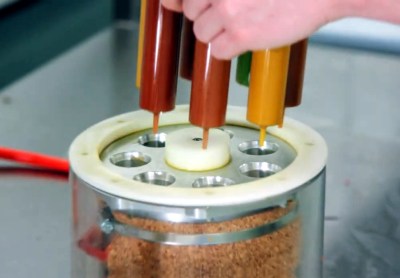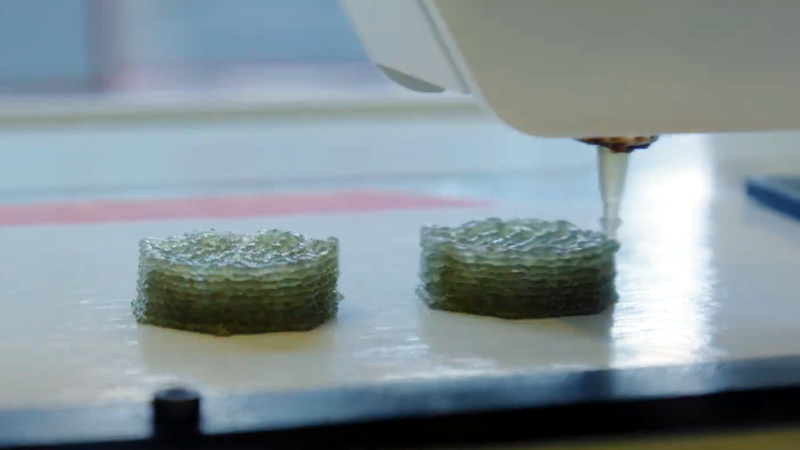It’s recently come to our attention that a company by the name of Nourished has carved out a niche for themselves by offering made-to-order gummy vitamins produced with their own custom designed 3D printers. Customers can either select from an array of pre-configured “stacks”, or dial in their own seven layers of gelatinous goodness for a completely bespoke supplement.
Now we can’t vouch for whether or not taking a custom supplement like this is any better than just popping a traditional multi-vitamin, but we’ll admit the hardware Nourished has developed is pretty interesting. As briefly seen in the video after the break, large syringes are filled with the seven different vitamin suspensions, and then loaded into what appears to be a heated chamber for extrusion. This is not unlike other food-grade 3D printers we’ve seen, such as the Cocoa Press.
 It looks like all of the syringes are being depressed simultaneously with a plate and a pair of beefy lead screws, so it seems the order in which the layers are placed down must be different for each nozzle. A blog post on the company’s site from early last year shows a wildly different machine being used to produce the vitamins, so either their core technology is changing rapidly, or perhaps the printer being used depends on whether they’re running off the customized stacks versus the standard formulations.
It looks like all of the syringes are being depressed simultaneously with a plate and a pair of beefy lead screws, so it seems the order in which the layers are placed down must be different for each nozzle. A blog post on the company’s site from early last year shows a wildly different machine being used to produce the vitamins, so either their core technology is changing rapidly, or perhaps the printer being used depends on whether they’re running off the customized stacks versus the standard formulations.
Interestingly, this is very similar to a concept floated by the U.S. Army’s Combat Feeding Directorate (CFD) back in 2014. They reasoned that a 3D printer could be used to produce meal bars that were customized for each soldier’s personal nutritional needs. Being largely impractical for the battlefield, the program didn’t get very far. But thanks to consumers who are willing to pay the premium that Nourished is charging for this service, it seems the idea has turned into a lucrative business model.















If they just do stacks, maybe making sheets of supplement, cutting and stacking them will be faster/cheaper? 3d printing is good if you need custom shapes.
If they had it all in powders they could just fill capsules too. So it does seem a bit gimmicky.
Agreed. Total Gimmick. No doubt they’ll be valued at hundreds of billions at some point. I’m surprised they aren’t called NRSHD or some such.
mind you, they did reverse the ‘E’ in the name, so maybe they are really clever after all?
Yeah the only niche I can see where this core concept actually works is in a situation like perhaps a space station. You print the required vitamin mix into the required food blends to meet the needs of the consumer with minimal waste. And as much of this food blend is likely to be created/shipped in paste form anyway, it might also make a good MRE companion – ship whole tubes of each blend to the front, in the same way letters got sent/revived eventually in WWII..
Otherwise why not just put the custom blend in the capsule, or even blend your personal mix into your condiment of choice…
Or make juicero for vitamins. A device refilled with only approved vitamins in paste form, which squeezes right amount, maybe even different blends depending on time of day, so that you don’t mix some ingredients in the same portion (I remember reading some opinions that some vitamins should not be mixed in the same serving or something like that ;) ).
All this thing is doing is portioning. You still need the same mass of ingredients as if they had been stuffed in capsules, it’s just more energy, time, and weight involved to get from storage to users.
It’s nutrition faddism, the robot.
Except because this is doing the portioning you don’t waste excess of anything – by shipping in capsules you will end up having to feed excess to provide enough – so you really do need less mass of initial ingredients with a system like this. Plus you’d have to carry all the mass of the capsules too.
Which is not say the system makes any sense in general.
My first thought was they’ve just reinvented the compounding pharmacy but with new buzz words.
Nope, just automated the tedious part of it.
Ah, vitamin supplements…the fastest way to achieve expensive urine!
How would one know how much of which vitamins to add the the mix? Maybe from your horoscope? Or a recommendation from your yoga teacher? Or maybe from a post you saw on facebook?
People are such sheep!
Well my Dr. said I had an extreme vitamin B and D deficiency which was cause other problems… so maybe not all are sheep.
Vegan?
I’ve had the same, and am not. Lots of causes of deficiencies, diet might be the most common, but its far from the only one.
You know, that got me thinking about this article: https://hackaday.com/2021/02/13/making-printed-food-more-palatable-for-those-who-need-it/
Then why not 3D print and dehydrate or freeze dry.
That get’s me wondering about what the nutritional content and nutritional stability data over time looks like for the food puree processed (dehydrated or freeze dried) dosage forms.
They give you a poll to see what overrall problems you have and what age/condition you are, then based on that they give you vitamins which typically treat those conditions. Of course you can first do blood checks, that will make it more targetted.
My horoscope is made by an expert at figuring out the positions of the stars and planets at the time of my birth, and their natural implications for my personality, health, and the overall trajectory of my life.
Are their “experts” more expert than that?
Honestly, you’re going to trust your health to a single, static data set, modified daily by a predictable, preset, rhythmic input? That’s going to have as much positive effect on your internal chemical balance as listening to a different radio station every day! Surely a more granular approach would be better using feedback from accurate sensors, such as a magnetic crystal headband, or the oxidation stain from your copper healing bracelet, or mood ring!
IIRC recent studies show that people who take supplements have a higher risk of loosing to entropy prematurely.
*losing
Yeah, vitamins are stupid, real men have scurvy!
First: if you eat relatively normal, you don’t need vitamins. With the exception of vitamin D3, which actually isn’t a vitamin, but a hormone.
Second: the pharmacist in me wonders about the thermostabilty of vitamins.
I’ll just stick with lots of veggies, fruits and nuts.
Let them pay a premium for eating green soylent
That’s just silly! Rely on a varied diet to get the vitamins and nutrients you need? Next you’re going to tell me that some of the stuff you eat actually tastes good! Why would anyone do such a thing when there’s a huge vitamin/nutritional supplement industry that needs your support?
It must be nice to have a large intestine.
Those of us without one definitely require nutritional supplements.
As a former professional vitamin wrangler (I developed nutritional supplements for a living) I can indeed confirm that most vitamins are not stable at elevated temperatures. Elevated temperatures and in a solution or suspension makes them doubly unstable.
“if you eat relatively normal, you don’t need vitamins”. But the question is what do you mean by a “normal” diet, a well balanced diet or the typical American diet?
Oh yah, I hate that statement, “The normal American/Canadian diet contains ample x, y or z” what the flying frick is normal??? Nowhere is there a simple breakdown of a normal diet.
Well the food guide is supposed to be “normal” but people are so different, who knows?
I can see having a system that automatically pumps varying amounts of different vitamins into a mixing chamber to get custom content. It’s not like the nutritional value is in the shape though. Why 3d print it? Once the right proportions are in the mixing chamber it should be able to just extrude it into a fixed shape cast or just plop it onto something like a cookie sheet to harden, be pried off and swallowed. Why print it bit by bit through a narrow nozzle?
For a vitamin where the format doesn’t necessarily matter, and for large-scale production, that’s a valid point.
For making small batches of custom compounds (like a compounding pharmacy does) in patient-specific shapes (different sizes of lozenges or suppositories) where the pharmacies have existing mold sets, it’s the only approach, and automates what they currently do by hand.
I’d only buy the supplements if the 3D printer used vacuum tubes on the control board, and monster copper cabling to the stepper motors, to give the extrusions a warmer and richer character.
I think vintage BC108s might also provide satisfactory results, maybe a big edgier?
The benefits go beyond custom formulations.
I worked at a company that makes a 3d “printer” (more of a “spooger”) that dispenses meds for compounding pharmacies.
These are small-batch meds (think a 1-4 weeks) mixed at pharmacies into lozenge and suppository formats. Having machines do the dispensing means the pharm/tech is freed up during the print to do other work instead of manually syringing tray molds, and trends towards more accurate fills.
Yeah drug compounding seems a better use case here, of course it’s one with a heck of a lot more regulatory overhead than “nutritional supplements” that can apparently do whatever the heck they want as long as no one realizes it’s the supplement making them sick.
Seems like this is a case of someone building a cool hammer and then couldn’t find the right shaped nail, so they started pounding on screws.
Reads like whomever was representing the U.S. Army for personalized nutrition, like medicine, wasn’t thinking wrong.
Future pharmacy thing for compounding meds?
Personally, I’d go with nutrients as medicine as the first line of prophylaxis defense or offense… then stepping up with phytochemical(s) before the other natural chems before the synthetics.
I’m having another one of those moments where I’m like… why aren’t there more chlorine or iodine forms of meds versus the more modern stuck with flourine entities, e.g. corticosteroids? On that topic was just yesterday reading regarding the apatite forms even where didn’t read much regarding iodine forms at all other than for nuclear waste remediation.
I must say, I’m a regular subscriber and it is not a gimmick! The reason they produce the stacks to order is so they have a higher absorption rate when you take them! Why take tablets for months / years when you can get the better outcome much quicker! Plus I’ve noticed my body changes through the seasons so I love that I can switch it up when my body needs. Don’t knock it until you’ve tried it people!
If your rate of absorption is rate limited, and renal or gastrointestinal clearance is concentration dependent, having a lot all in one hit won’t be equivalent to having the same amount spread out evenly over time. You will simply be creating expensive urine and/or stools.